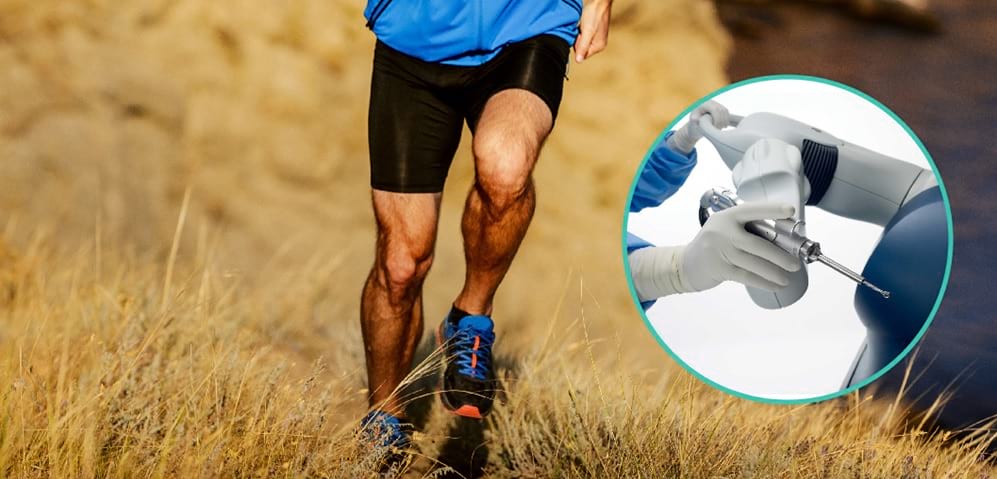At AIOR, we specialize in Robotic Knee Replacement surgery, employing the most advanced Orthopedic surgical Robotic Arm and PC Navigation technology. Our commitment is to ensure safer surgeries that result in rapid and healthy recovery.
Personalized Treatment Plans: Each patient presents a unique medical condition and analysis before undergoing Robotic Knee Replacement surgery. Dr. Ashish Singh, our esteemed orthopedic specialist in Patna, India, conducts a meticulous evaluation to tailor surgery plans specifically to each patient's needs.

Leading-Edge Technology: AIOR recently incorporated the cutting-edge LEO2 (MAKO) Robotic Arm by Stryker, enhancing our ability to provide personalized planning and procedures with precise adjustments for every patient. The use of the Leo2 Robotic Arm ensures accuracy and a high level of predictability, contributing to the overall success of the surgery.
AIOR is dedicated to delivering the best in orthopedic care, with a focus on innovation, precision, and patient-centric solutions, ultimately leading to optimal surgical outcomes.
Leading-Edge Technology: AIOR recently incorporated the cutting-edge LEO2 (MAKO) Robotic Arm by Stryker, enhancing our ability to provide personalized planning and procedures with precise adjustments for every patient. The use of the Leo2 Robotic Arm ensures accuracy and a high level of predictability, contributing to the overall success of the surgery.
AIOR is dedicated to delivering the best in orthopedic care, with a focus on innovation, precision, and patient-centric solutions, ultimately leading to optimal surgical outcomes.
PROCEDURE FOR ROBOTIC KNEE REPLACEMENT SURGERY
Initial Assessment: The process begins with a thorough evaluation of the patient's medical history, physical condition, and knee joint issues by the orthopedic surgeon.
Preoperative Planning: Utilizing advanced imaging techniques such as CT scans, a 3D virtual model of the patient's knee joint is created. This model serves as a precise guide for the surgery.
Robotic Arm Setup: The Robotic Arm system, such as the Leo2 (MAKO) by Stryker, is set up and calibrated for the specific surgery.
Surgical Incision: A small incision is made to access the knee joint. This minimally invasive approach reduces tissue trauma.

Real-Time Monitoring: Throughout the procedure, the Robotic Arm provides real-time data to the surgeon, enabling continuous assessment of joint movement and tension.
Adjustments (if Needed): If necessary, the surgical plan is adjusted in real time based on the data from the Robotic Arm to ensure optimal implant placement and alignment.
Closure and Recovery: After confirming the correct implant placement, the incision is closed. Patients are then moved to the recovery room.
Postoperative Care: Patients receive postoperative care, pain management, and physical therapy to aid in the recovery process.
Robotic Knee Replacement Surgery offers enhanced precision and accuracy, resulting in improved outcomes and a faster recovery for patients. It is essential to consult with an orthopedic surgeon to determine if this procedure is suitable for your specific condition.
Robotic Guidance: The Robotic Arm is employed to assist the surgeon in precisely positioning and preparing the knee for the implant.
Implant Placement: The damaged knee joint components are carefully removed, and the artificial knee components are precisely positioned and securely fixed in place.
ADVANTAGES
of Robotic Knee Replacement Surgery
Enhanced Precision: Robotic assistance provides unparalleled accuracy in implant placement and alignment, reducing the risk of errors and complications.
Personalized Planning: Each patient receives a customized surgical plan based on their unique anatomy, ensuring optimal implant size and placement.
Minimally Invasive: Robotic surgery typically involves smaller incisions, resulting in less tissue damage, reduced pain, and a quicker recovery.
Real-Time Monitoring: Surgeons receive real-time data from the Robotic Arm, enabling continuous assessment of joint movement and tension during surgery. Improved Implant Longevity: Precise positioning of implants can lead to a longer-lasting joint replacement, potentially reducing the need for revision surgery.
Faster Recovery: Patients often experience shorter hospital stays and quicker rehabilitation, allowing them to return to their daily activities sooner.
Reduced Pain: Smaller incisions and accurate placement of implants contribute to less postoperative pain.
Lower Risk of Complications: The high level of precision associated with robotic surgery can reduce the risk of complications and improve overall surgical outcomes.
Customized Treatment: Robotic technology tailors the surgery to each patient's specific needs, promoting better results.
High Success Rates: Robotic Knee Replacement Surgery has shown excellent success rates in improving joint function and quality of life for patients with knee joint issues.
It's important to consult with a qualified orthopedic surgeon to determine if Robotic Knee Replacement Surgery is the right option for your individual case.
PRECAUTIONS
after Robotic Knee Replacement Surgery
After the Robotic Knee replacement surgery there is a planned post surgery care provided by the AIOR group of best orthopedic doctors and their nursing team. At the same time this comes out to be successful only if the patient cooperates and puts efforts equally.
The precautions where the patient needs to pay his/her attention are:
LIFESPAN
of Implant after Robotic Knee Replacement surgery
LIFESPAN of Implant after Robotic Knee Replacement surgery can be longer, in general the lifespan of implants is around 15-20 years. The chances of successful positioning of the knee implant using Robotic arm LEO2 (MAKO) by stryker with pre and post surgery plans can increase the lifespan of the implant.
CONSULT AIOR FOR ORTHOPAEDICS PROBLEMS
Call Now 0612 2354130, +91 8448441016 and receive Top Quality Healthcare for you and your Family

